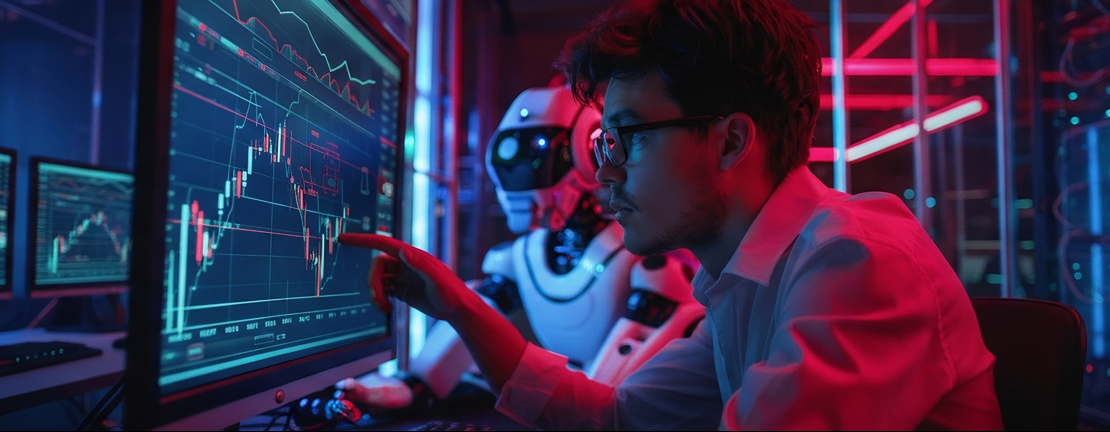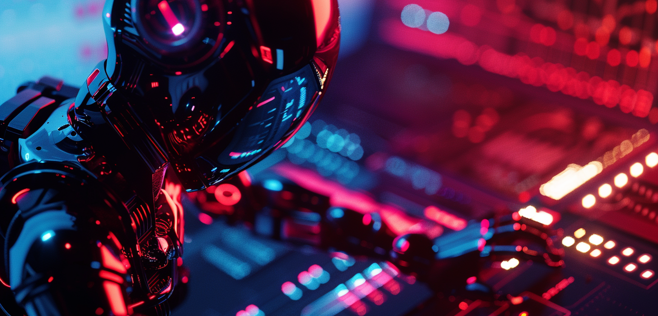Published 24 Sep 2025
AI Chart Reading in 2025: How Trading Signals Evolve

What Are AI Trading Signals and How Do They Work?
AI trading signals are not just an upgraded version of old chart alerts. They are complex outputs generated by machine learning models that process millions of data points in real time. Instead of focusing on a few technical indicators, these systems bring together price action, on-chain flows, liquidity dynamics, and sentiment data from multiple sources. The result is a signal that reflects the actual market state across several layers — from raw transactions to macro context.
Traditional trading signals usually depend on a fixed set of rules. For example, a moving average crossover or a candlestick formation triggers a buy or sell recommendation. The problem is that these rules are static. They don’t adjust to volatility spikes, sudden liquidity shifts, or cross-market correlations. AI-driven signals, on the other hand, are adaptive. They learn from historical data but also recalibrate continuously as new conditions emerge.
The workflow typically looks like this: raw data is collected from exchanges, blockchains, and news sources. Noise is filtered out, and features relevant to price behavior are extracted — such as order book imbalances, transaction velocity, or unusual wallet activity. Machine learning models then evaluate these features against thousands of prior market scenarios. The outcome is not just a “buy/sell” flag, but a structured blueprint with probability scores, confidence levels, and suggested execution parameters.
In practice, AI trading signals work more like data-driven hypotheses than absolute instructions. They highlight where the highest probability opportunities exist and leave room for human oversight or additional system checks. This makes them especially valuable in 2025, when markets are defined by speed, noise, and the constant interplay between retail behavior and institutional flows.

How AI Reads Charts and Patterns
AI has changed the way chart analysis works. Instead of manually spotting wedges, triangles, or divergences, machine learning systems scan thousands of assets across multiple timeframes at once. They detect both simple technical formations and more complex, non-linear relationships that human traders often miss.
The process begins with data preprocessing. Market noise is filtered out, and the information is normalized so the models can focus on signals that matter. From there, features are extracted — such as order book depth changes, abnormal volume clusters, RSI divergences, or liquidity shocks tied to wallet activity. These features are then tested against past data to see how they connect to future price behavior.
What makes AI unique is the ability to combine diverse inputs in real time. A model can read price action, volatility patterns, and order flows while also factoring in sentiment metrics and macro triggers. Instead of reacting to a single candlestick formation, it evaluates the probability of a broader market move based on thousands of parallel signals.
Most importantly, these systems adapt. Traditional chart tools treat the same signal the same way, regardless of context. AI systems recalibrate continuously, learning how a head-and-shoulders pattern behaves differently during high volatility, low liquidity, or strong macro pressure. This adaptive quality is why AI-driven chart reading has become a foundation for modern signal generation.

Role of Machine Learning in Signal Generation
Machine learning is the engine behind modern AI trading signals. These models don’t follow a rigid set of instructions — they learn from data and improve as conditions change. The approach is closer to how an experienced trader refines intuition, but scaled to millions of observations at once.
Different algorithms specialize in different tasks. Deep neural networks can process unstructured inputs like candlestick images or long-term chart patterns. LSTM networks are designed for time-series forecasting, making them effective for predicting price sequences. Models like Random Forest or XGBoost highlight which features — volume shifts, liquidity gaps, or sentiment surges — most strongly affect price moves. Reinforcement learning takes it further by allowing algorithms to adjust strategies dynamically, optimizing for profit and risk in changing environments.
The advantage of machine learning is consistency. Human traders are vulnerable to biases — seeing patterns where none exist or ignoring signals that conflict with their positions. Machine learning systems apply the same criteria every time, regardless of fear or market hype. They also capture connections invisible to the eye, such as subtle correlations between token velocity, derivative funding rates, and exchange inflows.
Instead of delivering absolute certainty, these models output probability distributions and confidence levels. A signal might not say “buy now” but rather “this setup has a 72% probability of breaking upward within the next 12 hours”. This probabilistic framework makes AI signals more aligned with risk-managed trading than with static chart rules.

Why AI Chart Reading Is Gaining Popularity in 2025
The growth of AI-driven chart reading in 2025 is not a trend — it’s a response to the complexity of modern markets. Liquidity now moves across multiple chains, information spreads instantly through social channels, and volatility can be triggered by both macro policy shifts and micro on-chain events. Traditional tools built around static indicators can’t keep up with this pace.
AI adds an edge through three core advantages. The first is speed. These systems process large volumes of market data in milliseconds, scanning order books, news, and sentiment in real time. In highly reactive markets, this difference in execution speed often defines whether a strategy captures an opportunity or misses it.
The second is emotional neutrality. Human traders often overreact to sudden price swings, letting fear or greed distort decisions. AI signals follow data, not emotions. This makes them particularly valuable during periods of extreme volatility, when discipline tends to break down.
The third is persistence. Cryptocurrency markets never close, and AI systems continue analyzing and executing strategies around the clock. This continuous monitoring means opportunities in Asia-Pacific or overnight U.S. sessions are treated with the same weight as during peak hours.
What makes 2025 different is the scale of adoption. AI signals are no longer experimental — they are becoming standard infrastructure across trading desks, hedge funds, and DeFi protocols. The reason is simple: they offer a systematic way to navigate markets that are too fast, too global, and too complex for manual analysis alone.

Types of AI Tools for Chart Reading and Trading Signals
AI trading solutions in 2025 fall into several categories. Each addresses different needs — from simple automation for beginners to advanced frameworks designed for institutions. Instead of thinking in terms of individual platforms, it’s more useful to group them by function and design.
Visual strategy builders
These tools let traders create automated systems through drag-and-drop logic rather than code. They are useful for retail users who want to experiment with systematic trading but don’t have programming skills. Visual builders often come with pre-set templates (for trend following, grid trading, or mean reversion) and allow quick backtesting.
Exchange-integrated terminals
Another class of tools focuses on consolidating positions across multiple venues. They combine advanced order types, risk controls, and portfolio management into a single interface. For active traders who operate across exchanges, this unified access reduces execution risk and improves efficiency.
Beginner-oriented automation
Some platforms focus on accessibility. They provide simple grid or DCA (dollar-cost averaging) bots that run continuously with minimal input. These services lower the barrier to entry for new market participants, making systematic strategies possible without advanced knowledge.
Open-source frameworks
Developer-friendly ecosystems emphasize flexibility and transparency. They allow full customization of trading algorithms, often running locally to minimize counterparty risk. Open-source models also build communities where strategies and code are shared, making innovation collaborative rather than proprietary.
Mobile-first AI agents
In 2025, mobile trading is standard. Tools built specifically for mobile interfaces provide on-the-go monitoring, push-based trade alerts, and lightweight execution bots. This makes algorithmic trading accessible to users who manage portfolios primarily from smartphones.
Decentralized AI protocols
Some projects bring AI-driven signals directly into DeFi. They use smart contracts to automate trades, create marketplaces for strategies, and allow users to lease or buy algorithms from other traders. This approach blends AI with token incentives, shifting control away from centralized platforms.
Rule-based automation with AI enhancements
Finally, there are systems that keep traditional “if-this-then-that” structures but overlay them with AI modules. These hybrid tools let users design simple strategies while the AI optimizes parameters or adapts conditions dynamically.
Together, these categories outline the landscape of AI trading tools in 2025. What matters is not the brand, but the design philosophy — accessibility, transparency, speed, or decentralization — and how well it fits the trader’s workflow.

How to Choose the Right AI Trading Software
Selecting an AI trading platform in 2025 is less about features on a website and more about how well the system fits into your trading workflow. The most advanced tool is useless if it cannot connect to your markets, protect your data, or scale with your strategies. Four criteria matter most.
Market and exchange integration
Compatibility defines usefulness. Some systems are designed for specific asset classes — crypto, forex, or equities — and may only support certain exchanges. Professional traders often require multi-exchange integration, cross-chain visibility, and APIs that allow automation without operational bottlenecks.
Strategy development and testing
AI tools differ in how much freedom they give you to design and refine strategies. Retail-oriented platforms provide visual builders and templates, while institutional-grade frameworks support coding environments, feature engineering, and large-scale backtesting. The depth of backtesting is critical: without it, strategies risk collapsing when exposed to live volatility.
Security and API control
API keys are the single most sensitive element in automated trading. Any serious platform should enforce strict permissions, encryption, and optional IP whitelisting. Systems that treat security as an afterthought increase exposure to both technical exploits and operational errors.
Cost structure and sustainability
Pricing models range from flat subscriptions to usage-based fees. Beyond subscription costs, traders need to account for data feeds, strategy marketplace purchases, and transaction costs. A platform is only viable if the potential risk-adjusted returns justify its total cost of ownership.
In short, the “best” AI trading software is context-dependent. A beginner building simple DCA bots and a fund running cross-exchange arbitrage need very different infrastructures. The right choice is the one that aligns with objectives, risk tolerance, and technical capacity — not just the one with the longest feature list.

Common Pitfalls and Risks of AI Crypto Trading
AI brings precision and scale to trading, but it also introduces risks that are often underestimated. Traders who treat algorithms as infallible tools face the same dangers as those who rely blindly on signals from anonymous chat groups. The difference is that the risks here are more technical — and sometimes harder to detect.
Overfitting to historical data
Machine learning models can become too closely tuned to past market behavior. When this happens, they capture noise instead of genuine structure. A strategy that performs flawlessly in backtests may collapse in live markets when volatility regimes shift. Overfitting is one of the most common failure points in algorithmic trading.
Opaque decision-making
Many AI systems function as black boxes. They generate outputs without showing the logic behind them. This lack of transparency makes it difficult to assess whether a model is acting on meaningful correlations or spurious patterns. In trading, opacity translates into unmeasurable risk.
Cost vs. returns
Advanced platforms often carry subscription fees, premium data charges, or marketplace costs for strategies. For smaller portfolios, these expenses can outweigh the gains from automation. Evaluating the risk-adjusted return relative to the total cost of ownership is essential before committing capital.
API and security vulnerabilities
The core link between a trading system and an exchange is the API key. If compromised, it gives attackers direct control over accounts. History shows that even reputable platforms have experienced leaks and breaches. Robust permission controls, IP restrictions, and operational discipline are mandatory to mitigate this risk.
In short, AI trading is powerful but not risk-free. The same tools that accelerate decision-making can also accelerate mistakes. Success depends on understanding these pitfalls, building safeguards around them, and treating AI as an assistant to market knowledge — not a replacement for it.

Real-World Use Cases of AI Trading Signals
The value of AI trading signals is best seen in practice. Different groups of traders apply these systems in ways that match their objectives, risk tolerance, and market knowledge. By 2025, use cases range from simple retail automation to institutional-level arbitrage.
Systematic accumulation for beginners
New investors often struggle with timing entries in volatile markets. AI-driven DCA (dollar-cost averaging) bots solve this by executing scheduled buys at fixed intervals. The automation removes emotion, reduces the risk of chasing price swings, and allows portfolio building without constant monitoring.
Intraday precision for active traders
Day traders rely on AI signals to manage the speed of short-term markets. Machine learning models that track order book depth, volume spikes, and liquidity imbalances generate entry and exit levels with higher accuracy than manual charting. For traders who live on microstructure shifts, this precision is critical.
Cross-exchange arbitrage for advanced users
At the institutional level, custom AI agents run strategies that exploit inefficiencies across venues. These agents monitor liquidity flows, funding rates, and sentiment shifts in real time. They move capital dynamically between exchanges, lending markets, or DeFi protocols — adjusting positions in milliseconds to capture spreads.
What unites these examples is not a specific tool but the principle: AI scales human capacity to analyze, react, and execute in markets where speed and data density overwhelm manual methods. The technology does not erase risk, but it changes how risk is managed — from intuition-driven guesses to probability-weighted strategies.

Conclusion
AI chart reading in 2025 is no longer a niche experiment — it has become part of the trading infrastructure. These systems process vast datasets, recognize patterns across multiple layers of the market, and deliver probability-based signals that humans cannot generate at scale.
Yet, the role of AI is not to replace traders. Its real value lies in extending analytical capacity, filtering noise, and enforcing discipline where emotions normally distort judgment. The traders who benefit most are those who integrate AI signals into broader strategies — combining them with on-chain metrics, macro context, and their own risk frameworks.
The trend is clear: as markets grow faster and more interconnected, adaptive AI models will define how signals are generated and executed. But the edge will still depend on understanding the limits of automation and using it as a complement to market knowledge, not a substitute.
For RateXAI, this shift reinforces a core principle: the future of trading belongs to those who can align high-quality data, adaptive algorithms, and human judgment into one decision-making framework.
Read More




 Get RateX Pro
Get RateX Pro

 06 Jun 2024
06 Jun 2024
